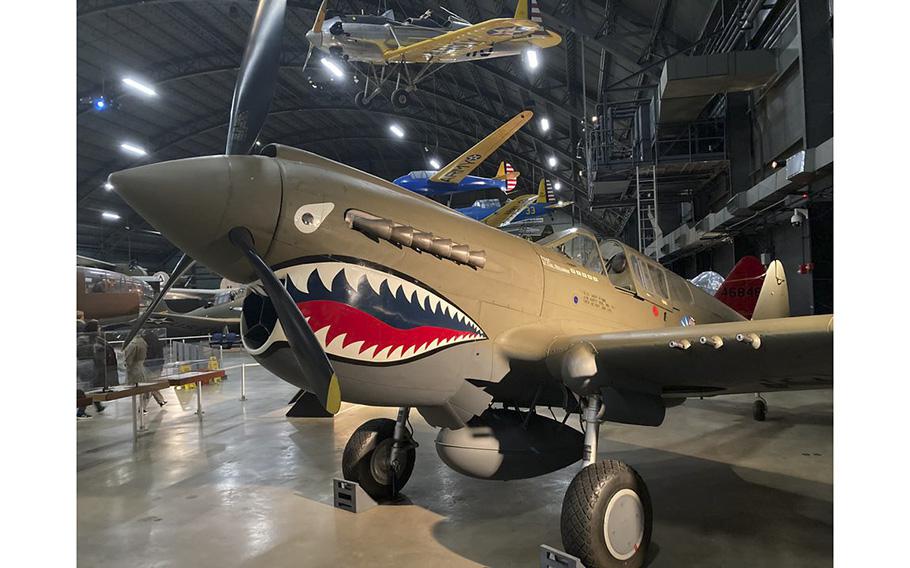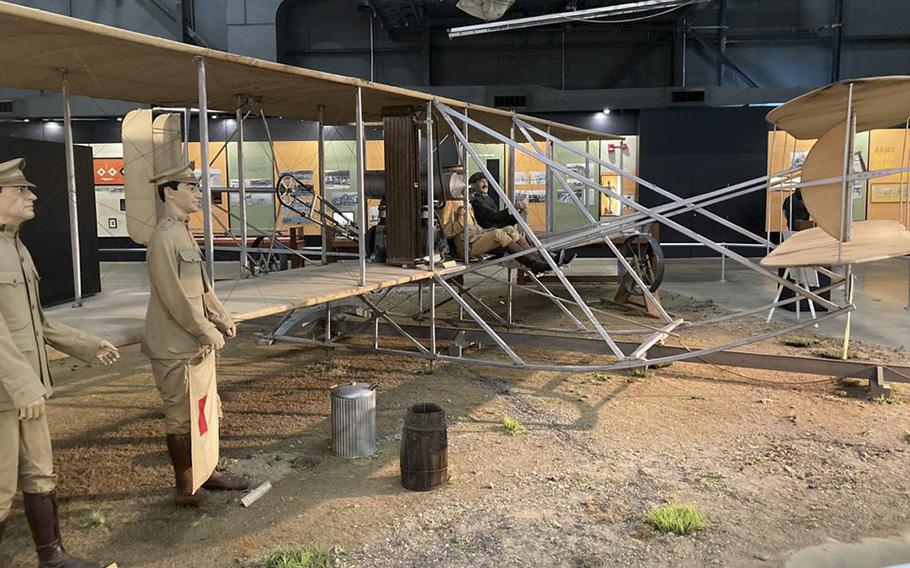
A Curtiss P-40E Kittyhawk, a World War II fighter plane, painted as a Flying Tiger at the National Museum of the U.S. Air Force. (Susan Glaser/TNS)
DAYTON, Ohio (Tribune News Service) — Decades before there was a U.S. Air Force, there was an air force museum, with early airplane parts and other memorabilia on display in a field just north of downtown Dayton.
This year, that museum is celebrating its 100th birthday, now a massive complex in suburban Dayton that provides a window into some of this country’s most important moments.
There’s the airplane that dropped the atomic bomb on Nagasaki, ending World War II. The presidential vehicle that transported the body of slain President John F. Kennedy back to Washington, D.C. after he was killed in Dallas. And there’s an exact replica of a Wright 1909 Military Flyer, the world’s first military aircraft, manufactured in Dayton.
And in between those vehicles – airplanes to walk through, giant missiles to gaze up at, cockpits to sit inside and hundreds of inspiring stories of the men and women who put their lives on the line for the rest of us day after day.
It’s an insightful and thought-provoking place even for those of us who are not overly interested in big aircraft and bigger battles. This place chronicles the history of our nation – from the innovation of early flight in the early 1900s through two world wars, the controversies of Vietnam and Iraq, the nuclear arms race, space travel, presidential milestones and more.
The museum traces its roots back to 1923, when Army engineers were studying the aviation successes of World War I. They accumulated a collection of engines and other aircraft parts at Dayton’s McCook Field, home to a small army base.
“And they decided to open their doors to the public,” said Meghan Anderson, curator at the National Museum of the U.S. Air Force.

An exact replica of a Wright 1909 Military Flyer, the world’s first military aircraft, manufactured in Dayton. (Susan Glaser/TNS)
In the 100 years since, that museum has expanded, relocated, shut down and expanded again. It moved to its current location in 1971.
Today, the museum is spread across four massive hangars, covering more than a million square feet of exhibit space. More than 300 aircraft are on display, with another nearly 400 in storage or on loan.
If you’ve never been to the National Museum of the U.S. Air Force – or if it’s been a while — maybe this is the year to make the three-hour drive from Cleveland to Dayton. It’s one of Ohio’s top tourism sites for a reason. And good news – it’s free.
Starting with the Wrights
It’s possible to do it all in one day – I did, on a visit last month – but you might want to spread it over two days, and take in some additional Wright Brothers sites in Dayton during your stay.
The galleries are organized by time period – Early Years, World War II, Korea, Southeast Asia, the Cold War, Space and more – and can be toured chronologically or by area of interest.
Among the don’t-miss aircraft: the B-2 Stealth Bomber, with its sleek batwing design and ability to evade radar (Cold War); a space shuttle crew compartment trainer, used to train shuttle astronauts (Space); and the C-141C Hanoi Taxi, which earned its nickname at the end of the Vietnam War, when it airlifted the first American prisoners of war to freedom (Global Reach).
There’s the Apollo 15 command module Endeavour, used during the 1971 moon mission with an all-Air Force crew; a massive Titan IVB launch rocket, designed to carry military satellites into space; and the XB-70A Valkyrie, the supersonic nuclear bomber that was developed in the 1960s but never produced. The prototype here is the only one in existence.
Also here: The National Aviation Hall of Fame, honoring 250 pioneers of flight, including Orville and Wilbur Wright, the very first inductees, in 1962.
The Wrights’ work is covered in the Early Years gallery, including their flight experiments at nearby Huffman Prairie (now part of Dayton Aviation Heritage National Historical Park). A replica of the world’s first military plane, built in 1909 in Dayton and sold by the Wrights to the Army for $30,000, is on display here. (The original, alas, was donated to the Smithsonian in 1911 and is on display at the National Air and Space Museum in Washington, D.C.)
Also of note: A case of items retrieved from Quentin Roosevelt, a World War I pilot with the U.S. Army Air Service and the youngest son of 26th President Theodore Roosevelt. Roosevelt was shot down over Germany during an air combat mission, his grave marked by a cross of two basswood branches, also on display here.
And in the World War II gallery
• The famed Boeing B-17F Memphis Belle, the first heavy bomber to return to the United States after completing 25 missions over Europe. The plane, featured in two films, relocated to Dayton in 2005, where it underwent a 13-year-old restoration process. It has been on display since 2018.
• A Curtiss P-40E Warhawk, painted as a Flying Tiger, with the aircraft’s trademark shark mouth; and a Mitsubishi A6M2 Zero, used in Japanese kamikaze attacks.
• The Boeing B-29 Bockscar, which dropped the atomic bomb on Nagasaki on Aug. 9, 1945, described as “the aircraft that ended World War II.” It’s displayed next to a replica of Fat Man, the bright-yellow, 10,000-pound nuclear weapon that was dropped.
An exhibit inside the Cold War gallery digs deeper into the nuclear arms race, listing the countries that have tested nuclear weapons in the years since World War II (eight, if you’re counting: the U.S., Soviet Union, United Kingdom, France, China, India, Pakistan and North Korea).
On display here: a mangled Lockheed XF-90, which was used to test how nuclear explosions in the Nevada desert would affect parked aircraft. The answer: not well.
As I wandered the Cold War gallery, I was struck by the irony of some of the names of the aircraft and missiles displayed here, including “Peacekeeper” intercontinental ballistic missiles, developed in the 1980s; and the massive Convair B-36J “Peacemaker” aircraft, built in the late 1940s and 1950s, capable of carrying 86,000 pounds of nuclear bombs.
Did these weapons keep the peace or escalate a never-ending game of chicken? Given current world events, I’m not sure the answer is clear.
Other exhibits, too, go beyond the aircraft to discuss the people and the politics of the times.
Don’t miss the exhibit on the Tuskegee Airmen, the group of Black military aviators who trained at Tuskegee Army Air Field in Alabama in the early 1940s. Their success in World War II ultimately led President Truman to desegregate the U.S. Armed Forces in 1948.
It would take longer for women to earn their place as Air Force pilots.
In 1930, the chief of the U.S. Army Air Corps argued that women were too “high-strung” to become pilots, according to an exhibit in the World War II gallery. Twelve years later, during World War II, the Army created the Women Airforce Service Pilots (WASP), a civilian group that tested aircraft and trained flyers. But it was disbanded at the end of the war.
It wasn’t until 1975 that the Air Force allowed women to become pilots. Even then, some participants weren’t sure their success was part of the plan.
“I didn’t feel like they wanted to learn how to best train women pilots as much as have an excuse to terminate the test program,” said Major Carol Scherer, whose Air Force jumpsuit is on display at the museum.
The human toll of war is told through the story of Air Force Lt. Lance Sijan, a prisoner of war who was shot down over Laos in November 1967 and captured 46 days later. Sijan, who died in captivity, was the first graduate of the U.S. Air Force Academy to receive the Medal of Honor.
Re-created prison cells depict dire conditions at Hoa Lo Prison, better known as the Hanoi Hilton, the notorious facility in Vietnam, where prisoners sometimes communicated using a series of taps through the walls.
It’s not all so grim. A new exhibit explores the many Air Force non-combat missions, including global firefighting, disease control, natural disasters and search and rescue. The Air Force even helped relocate hundreds of Adelie and emperor penguins from Antarctica to the United States for research and study.
After World War II, the Air Force engaged in what was perhaps its best-known humanitarian mission — the Berlin Airlift, when they provided food and other supplies to isolated residents in West Berlin. The mission is highlighted through a series of life-sized dioramas set up between the World War II and Cold War galleries.
Presidential aircraft
When President John F. Kennedy traveled to Berlin in June 1963 to make his famous “Ich bin ein Berliner” (I am a Berliner) speech, he flew aboard a retrofitted Boeing 707 dubbed SAM 26000, better known as Air Force One. Months later, the same aircraft would carry Kennedy’s body back to Washington, D.C., from Dallas.
Visitors can walk through the plane to see where Lyndon Johnson took the oath of office shortly after Kennedy’s death and where the seats were removed to accommodate Kennedy’s body, as first lady Jacqueline Kennedy did not want the casket in cargo.
It’s one of 10 presidential aircraft on display within the museum, and one of four that visitors can walk through, perusing the relatively spacious accommodations alongside what must have then been state-of-the-art technology (but seems archaic now).
Inside the Douglas VC-54C Skymaster, dubbed Sacred Cow, used by presidents Franklin Roosevelt and Harry Truman: a conference room with large desk and bulletproof window, a fold-down bed, an electric refrigerator and a battery-powered elevator that allowed Roosevelt to discreetly board the aircraft in his wheelchair.
In 1947, Truman was inside the aircraft when he signed the National Security Act of 1947, which, among other things, finally established the U.S. Air Force as an independent branch of the military.
The air force museum, of course, had been established much earlier.
©2023 Advance Local Media LLC.
Visit cleveland.com.
Distributed by Tribune Content Agency, LLC.